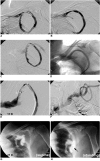Percutaneous intervention in axillary loop-configured arteriovenous grafts for chronic hemodialysis patients
- PMID: 20191067
- PMCID: PMC2827783
- DOI: 10.3348/kjr.2010.11.2.195
Percutaneous intervention in axillary loop-configured arteriovenous grafts for chronic hemodialysis patients
Abstract
Objective: The purpose of this study was to evaluate the fistulographic features of malfunctioning axillary loop-configured arteriovenous grafts and the efficacy of percutaneous interventions in failed axillary loop-configured arteriovenous grafts.
Materials and methods: Ten patients with axillary loop-configured arteriovenous grafts were referred for evaluation of graft patency or upper arm swelling. Fistulography and percutaneous intervention, including thrombolysis, percutaneous transluminal angioplasty and stent placement, were performed. Statistical analysis of the procedure success rate and the primary and secondary patency rates was done.
Results: Four patients had graft related and subclavian venous stenosis, two patients had graft related stenosis and another four patients had subclavian venous stenosis only. Sixteen sessions of interventional procedures were performed in eight patients (average: 2 sessions / patient) until the end of follow-up. An interventional procedure was not done in two patients with central venous stenosis. The overall procedure success rate was 69% (11 of 16 sessions). The post-intervention primary and secondary patency rates were 50% and 63% at three months, 38% and 63% at six months and 25% and 63% at one year, respectively.
Conclusion: Dysfunctional axillary loop-configured arteriovenous grafts almost always had subclavian venous and graft-related stenosis. Interventional treatments are helpful to overcome this and these treatments are expected to play a major role in restoring and maintaining the axillary loop-configured arteriovenous loop grafts.
Keywords: Dialysis; interventional procedure Veins; shunt Graft; transluminal angioplasty.
Figures




Similar articles
-
Stent-grafts improve secondary patency of failing hemodialysis grafts.J Vasc Access. 2012 Jan-Mar;13(1):65-70. doi: 10.5301/JVA.2011.8485. J Vasc Access. 2012. PMID: 21748724
-
Arteriovenous Hybrid Graft with Outflow in the Proximal Axillary Vein.Ann Vasc Surg. 2017 Jul;42:39-44. doi: 10.1016/j.avsg.2017.02.002. Epub 2017 Mar 24. Ann Vasc Surg. 2017. PMID: 28344184
-
Long-term outcomes of primary angioplasty and primary stenting of central venous stenosis in hemodialysis patients.J Vasc Surg. 2007 Apr;45(4):776-83. doi: 10.1016/j.jvs.2006.12.046. J Vasc Surg. 2007. PMID: 17398386
-
The role of interventional radiology in management of patients with end-stage renal disease.Eur J Radiol. 2003 May;46(2):96-114. doi: 10.1016/s0720-048x(03)00074-3. Eur J Radiol. 2003. PMID: 12714226 Review.
-
Radiological intervention to maintain vascular access.Eur J Vasc Endovasc Surg. 2006 Jul;32(1):84-9. doi: 10.1016/j.ejvs.2005.10.004. Epub 2005 Nov 16. Eur J Vasc Endovasc Surg. 2006. PMID: 16297644 Review.
Cited by
-
Efficacy of a modified pharmacomechanical thrombolysis technique for endovascular treatment of thrombosed prosthetic arteriovenous grafts.Korean J Radiol. 2012 May-Jun;13(3):300-6. doi: 10.3348/kjr.2012.13.3.300. Epub 2012 Apr 17. Korean J Radiol. 2012. PMID: 22563267 Free PMC article.
-
[Long-term results of chest wall arteriovenous graft for establishing hemodialysis access].Zhongguo Xiu Fu Chong Jian Wai Ke Za Zhi. 2019 Feb 15;33(2):227-231. doi: 10.7507/1002-1892.201802003. Zhongguo Xiu Fu Chong Jian Wai Ke Za Zhi. 2019. PMID: 30739421 Free PMC article. Chinese.
References
-
- Fan PY, Schwab SJ. Vascular access: concepts for the 1990s. J Am Soc Nephrol. 1992;3:1–11. - PubMed
-
- Hazinedaroğlu S, Karakayali F, Tüzüner A, Ayli D, Demirer S, Duman N, et al. Exotic arteriovenous fistulas for hemodialysis. Transplant Proc. 2004;36:59–64. - PubMed
-
- Jean-Baptiste E, Hassen-Khodja R, Haudebourg P, Declemy S, Batt M, Bouillanne PJ. Axillary loop grafts for hemodialysis access: midterm results from a single-center study. J Vasc Surg. 2008;47:138–143. - PubMed
-
- Morsy MA, Khan A, Chemla ES. Prosthetic axillary-axillary arteriovenous straight access (necklace graft) for difficult hemodialysis patients: a prospective single-center experience. J Vasc Surg. 2008;48:1251–1254. - PubMed
-
- Teruya TH, Schaeffer D, Abou-Zamzam AM, Bianchi C. Arteriovenous graft with outflow in the proximal axillary vein. Ann Vasc Surg. 2009;23:95–98. - PubMed
MeSH terms
LinkOut - more resources
Full Text Sources
Medical

